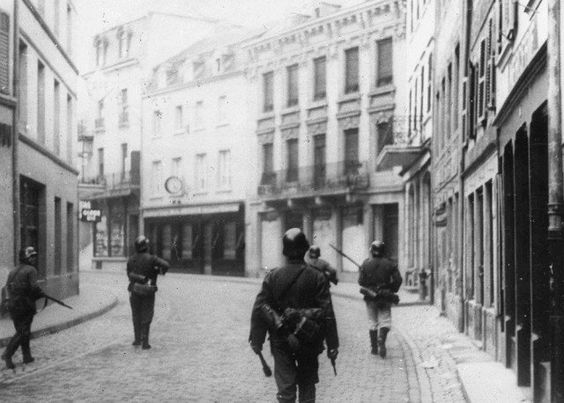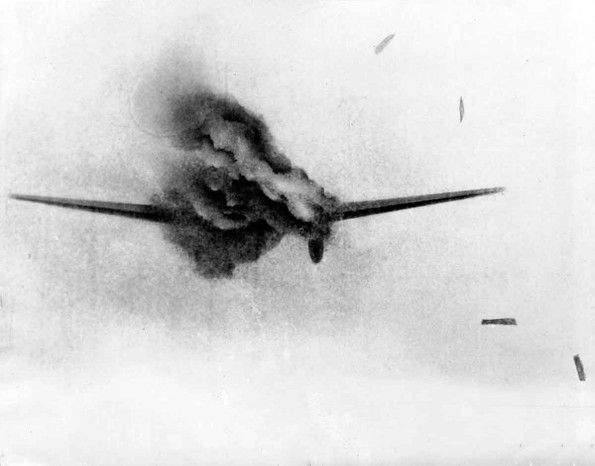Tuesday 21 May 1940
 |
| A German patrol in the silent streets of Luxembourg, potato mashers, pistols and rifles at the ready. 21 May 1940. |
Major-General Harold Franklyn commands tank forces in the Arras area of the British 5th Infantry Division, the 50 Infantry Division and the French 3rd Light Mechanized Division. The Allied high commands have not formulated a coordinated plan to pinch off the German spearhead, so he essentially is acting on his own despite large nearby French armored forces, including some of the SOMUA S35 heavy tanks that had proven superior at the Battle of Hannut. Franklyn's mission is muddled: he is not told of a clear objective, just to attack. In the event, he assumes that his mission is to relieve Arras, not re-establish vital communications to the south with France.
Franklyn sends in 74 Matilda tanks and 14 light tanks, keeping the strong French tanks for flank protection. He achieves surprise. The British Matilda tanks stand up quite well to standard German antitank guns. Radio communication is poor, and the tanks are not adequately supported in a modern combined-arms fashion. The British make some early gains. Rommel's 7th Panzer Division is vulnerable because he has sent units ahead, bypassing Arras - and leaving his center weak. If there is one weakness of Rommel's style of leadership, this is it.
As is often the case with unexpectedly powerful enemy tanks, the Germans always have an ace in their pocket with their 88 mm (3.46 in) FlaK guns and 105 mm (4.1 in) field guns). While not particularly mobile, they are devastating when used over open sights against nearby ground targets - at great risk to the guns' crews, of course. In addition, Rommel's penchant for stringing out his forces - which so panics his tradition-minded superiors - pays massive dividends. Rommel is able to recall an advanced panzer regiment which returns and takes the advancing British in a devastating flank attack.
The British tanks falter, then retreat, harassed by the Luftwaffe all the way. The British lose 60 of their 88 tanks, while Rommel only loses 89 killed, 110 wounded and 173 missing. It is a huge tactical defensive victory for the Wehrmacht. However, the attack greatly impresses the German OKW high command - and particularly Hitler. It might have made some real impact if coordinated with de Gaulle's abortive attack from the south on 19 May.
The Battle of Arras has long-lasting effects. One theory of German tank development is that this encounter at Arras so impresses Hitler with the superiority of heavily armored British tanks that he puts in place the design program that ultimately leads to the Panzer VI Tiger Tank of 1942. The battle also is when the Allies begin to speak of "German 88s" with respect. The failure of the attack makes the senior British leadership - if not the French - even leerier about the BEF's prospects on the Continent. Finally, the ferocity of the attack is giving the top brass second thoughts about pressing home the attack against the quickly contracting First Army Group as it bellies up beside the sea.
To the southwest, General Guderian's panzers consolidate their hold on the Somme. The 1st Panzer, 2nd Panzer, and 10th Panzer Divisions take bridgeheads across the river. These will be quite handy when the time comes to head south.
The Germans besiege Maubeuge, west of Dinant on the River Sambre. The French Ninth Army, having lost its commander General Giraud when captured by German troops, is in a state of collapse.
French Commander-in-chief Weygand is continuing to "assess the situation." He goes to Ypres to meet with King Leopold, General Gaston Billotte, commander of the 1st Army Group, and General John Vereker Lord Gort, commander of the BEF. Billotte is depressed and pessimistic, and Gort misses the meeting entirely. After the meeting, Billotte - who has Weygand's plan in his head for a coordinated attack against Rommel's panzers from north and south - gets in a major car accident, leaving him in a coma and near death. Gort's Chief of Staff, not one to mince words, observes caustically, "With all respect, he's no loss to us in this emergency" - which is a bit unfair because Billotte was the key to the counterattack, which now does not take place. General Blanchard, heretofore in charge of French 1st Army, takes over as Cinc of 1st Army Group.
European Air Operations: The RAF is in full battle mode. It attacks the German ground troops during the day and sends 124 bombers total (sources vary) to take out road and rail targets at night in Namur, Dinant, and Aachen, as well as the German troops outside Arras.
The RAF completes its evacuation from Belgium. Air cover over the BEF henceforth will originate from either France or England. This is not optimal for the gun-carrying infantry still trying to hold tenuous lines that keep shifting back toward the coast.
First victory of "Sailor" Malan of RAF No. 74 Squadron.
Battle of the Atlantic: The Luftwaffe catches French destroyer L’Adroit off Dunkirk and bombs and sinks it. They also sink - perhaps inadvertently - British hospital ship Maid of Kent off Dieppe, along with British ship Hubbastone at Dieppe.
British ship Firth Fisher hits a mine and sinks off Boulogne.
The British commission corvette HMS Hibiscus (K 24) (Lt. Commander Reginald Phillips).
Battle of the Pacific: German raider Orion rounds Cape Horn into the Pacific.
Norway: The German 2nd Mountain Division continues advancing past Mo i Rana toward Bodo and takes up positions on the north shore of the Rombaksfiord. Colonel Gubbins plans to mount a defense at Storjord, 20 miles (32 km) south of Rognan - if he can get the Scots Guards under Lieutenant Colonel Thomas Byrnand Trappes-Lomax to stop their retreat.
Royal Navy aircraft carrier Furious sends off 18 Gladiators of No. 263 Squadron and 18 Hurricanes of 46 Squadron to man a base at Bardufoss north of Narvik. Luftwaffe dominance of the northern Norway skies is becoming a problem, perhaps a decisive one. It is easy to question priorities since British fighters are being withdrawn from the decisive Western Front at the same time as they are being sent to the sideshow in northern Norway. This is just another indication of the tremendous strategic importance placed on the Swedish iron ores which flow through northern Norway at Narvik.
War Crimes: There are many anecdotal reports of Luftwaffe fighters and Stukas strafing refugees on the roads. Doing so would both block the roads and sow terror about the chilling new aerial weapons of the Luftwaffe - the Stukas have had air horns installed specifically to enhance the terror effect. These types of incidents are extremely difficult to prove, and they may not necessarily be intentional war crimes. However... intentionally targeting civilians in such a manner most definitely is a war crime.
German Military: Hitler and Raeder hold a conference. Raeder has radical ideas about naval strategy - he was the architect of the invasion of Norway, Operation Weserubung - and now he has another idea: invade Great Britain. This is the first record of anyone even broaching this topic in a serious manner. Hitler agrees with the proposal but also tells Commander-in-chief Brauchitsch and his chief of staff Halder that he wants to do a deal with Great Britain.
Soviet Military: General Alexander Vasilevsky becomes 1st Deputy Head of Operations Directorate of the Stavka.
USS Military: The submarine USS Trout is launched.
Gibraltar: Non-essential personnel being evacuated to England. Nobody knows Francisco Franco's intentions, and Gibraltar would be indefensible if Spain joins the Axis.
France cannot die! …. if I were told tomorrow that only a miracle could save France, I should reply: I believe in miracles because I believe in France!His ultimate conclusion is that the problem facing the nation stems from failure to understand the recent evolution of military doctrine - something that Brigadier General Charles de Gaulle has become known for.
United States Government: President Roosevelt sends a secret executive order to FBI Director Edgar Hoover: wiretap foreign agent suspects. This includes members of foreign embassies and consulates. This is a highly controversial decision that is of dubious legality - especially with the US not at war with anyone.
Dutch Homefront: The influence of the German occupation already is being felt. Radio broadcaster AVRO dismisses its Jewish employees.
American Homefront: While the Germans and the Allies are locked in their brutal beat-down in Belgium and France, US journalists are able to provide stateside readers with accounts from both sides. Journalist William Shirer, for instance, is one of several US newspapermen accompanying the Wehrmacht on its glory ride. He notes rather tonelessly that "Our Wehrmacht officer guide is very complimentary to the French." It is not safe to report from the front, as the journalists are as exposed as anyone to air attacks.
Future History: Tony Sheridan is born in Norwich, Norfolk, England. He becomes famous as a singer after he collaborates with an unknown group known as The Beat Brothers in 1961. They release a single ("My Bonnie") that makes it to No. 5 on the German chart. This is not when he becomes famous as a result of the collaboration, but rather after The Beat Brothers change their name to The Beatles.
May 1940
May 1, 1940: British Leave ÅndalsnesMay 2, 1940: British Depart Namsos
May 3, 1940: Many Norwegians Surrendering
May 4, 1940: Bader Returns
May 5, 1940: HMS Seal Survives
May 6, 1940: Allies Focus on Narvik
May 7, 1940: In The Name of God, Go!
May 8, 1940: Exit Chamberlain
May 9, 1940: Enter Churchill
May 10, 1940: Fall Gelb
May 11, 1940: Eben Emael Surrenders
May 12, 1940: Germans at Sedan
May 13, 1940: Rommel at Work
May 14, 1940: German Breakout in France
May 15, 1940: Holland Surrenders
May 16, 1940: Dash to the Channel
May 17, 1940: Germans Take Brussels
May 18, 1940: Germans Take Antwerp
May 19, 1940: Failed French Counterattack
May 20, 1940: Panzers on the Coast
May 21, 1940: Battle of Arras
May 22, 1940: Attacking Channel Ports
May 23, 1940: British Evacuate Boulogne
May 24, 1940: Hitler's Stop Order
May 25, 1940: Belgian Defenses Creaking
May 26, 1940: Operation Dynamo
May 27, 1940: King Leopold Surrenders
May 28, 1940: The Allies Take Narvik
May 29, 1940: Lille Falls
May 30, 1940: Operation Fish
May 31, 1940: Peak Day for Dynamo
2020


No comments:
Post a Comment